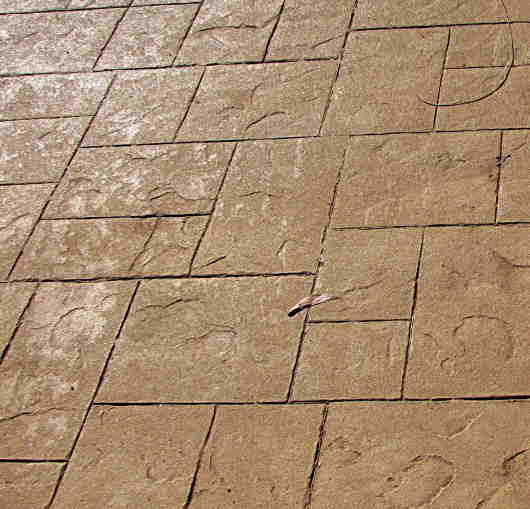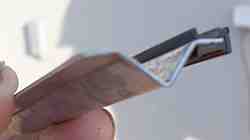stamped concrete,decorative concrete, concrete skins
One of the earliest methods of creating decorative effects in wet flatwork,stamped concrete. Along with the use of skins it is still a common technique.
Material suppliers use words like durable, economical, easy to maintain etc. etc.
They are right also. I tend to put this type of decorative concrete into the boring and old fashioned category but a swift check around the web has shown me the error of my ways.
 |
| Stamped concrete - A fairly bland single colour driveway. |
- The old standards of patterns that replicate natural stone, brick, tiles or slate are still the stand byes.
- Now people are starting to use found objects to create unique hand worked effects.
- The use of liquid or powder based stains actually incorporated into the mix can give an even surface colour.
- Increasingly, especially on internal floors the use of various strong acid stains or liquid dyes after the concrete has set can pick out certain areas of the patterns creating unusual effects.
- The actual stamps used can vary from shaped rubber mats, metal patterns, to open metal sheets that resemble pieces of reinforcing mesh. They can also take the form of embossed rollers.
- Unlike stencils, the stamps are reusable many times, which helps to offset their increased cost.
- The metal stamps are a certain size and any odd increment may have to be worked into the wet cement by hand tools such as special shaped jointers etc.
- Once again combinations of different decorative concrete techniques are possible. You may seed the concrete, trowel or roll the seed in. then stamp with a deep pattern, then at the appropriate time give the surface a light exposed aggregate finish.
- Surface texturing is possible over the whole of the slab from light impression of say a slate texture to heavy horizontal anti skid lines to a steep driveway.
NOTE! - for very fine detail to internal work it may be sometimes necessary to work with a finer aggregate topping mix after the main structural slab is set. This gives the opportunity to work on smaller sections with not the same time constraints that exist on larger pours.
Depending on the type for stamping to be done many suppliers can make up a modified mix with a finer type of sand. Another aspect of the difference between stamped concrete and standard concrete is the use of surface evaporation retarders. These help to keep the surface workable for longer periods than normal. They become more necessary when hot and windy conditions cause the concrete surface to dry quickly.
Warning - Many of the stamp effects are quite deep. If your specification calls for 100 thick concrete and you stamp is 15mm deep, do the right thing and make your slab at least 115 deep. You do not want you beautiful new slab marred by unsightly cracks.
A stamped concrete how to
 |
| Stamped concrete - A metal control joint that causes a weak line in the slab, so the concrete will crack under, but the top will have a straight, the top wider rubber insert is removed after the concrete has set leaving a nicely defined edge with a "U" shaped rubber protector for the metal. |
As usual I am repeating myself here, but it is a point worth repeating. Plan ahead the placement of the expansion joints and the control joints. Just because your pattern may not suit the maximum spacing of 30:1 joint to thickness of slab ratio, don't stretch it. Go to smaller control joint distances rather than larger. Also don't forget isolation joints to abutting structures.
- Protect all adjoining surfaces from splashing by the wet mix or dry powder. See this tip for the best way to do it.
- The concrete is placed in the normal way. It is screeded or leveled and the bleed water or laitance is allowed to dry off.
- At this stage if the slab is to be coloured or if secondary colours are added over a coloured mix with dry shake powder then it is done now. You need to set up planks over the surface so that you can get close to all parts of the work area and get an even coat.
- If surface retarders are used then they are sprayed on next. These retarders can have a couple of beneficial side effects. They can reduce the small plastic shrinkage cracks that often occur, and at the same time they can improve the workability of the concrete.
- The stamps, mats or skins used to make to patterns are expensive and easily clogged or damaged, so to stop this a release agent is applied to the surface. This can take the form of a powder that may be tinted to various colours or it can in fact be a sheet of thin plastic sheet over the concrete surface so that the stamps never contact the actual concrete.
- As in most decorative surfaces stamped concrete is not normally cured with a plastic sheet, because this can cause uneven marks on the surface.
- The preferred method of curing is a spray on curing compound-sealer.
- If however a powdered release agent has been used then the curing sealer can't be applied until the concrete has set, usually overnight, and the release agent has been water blasted off.



